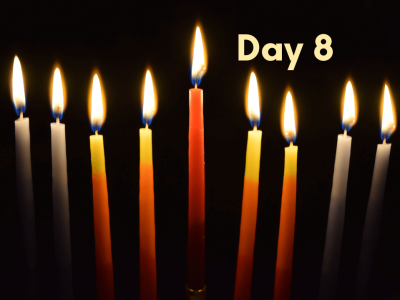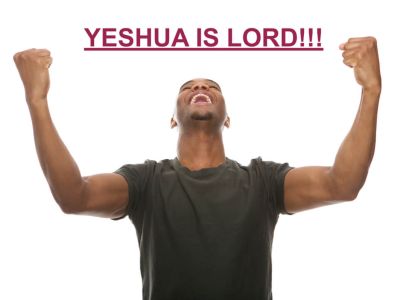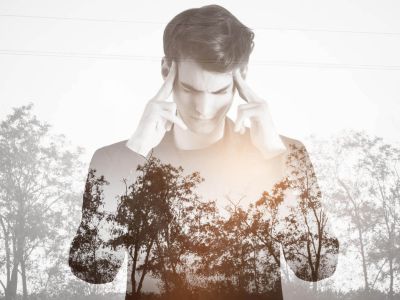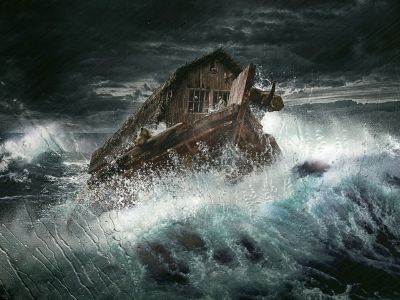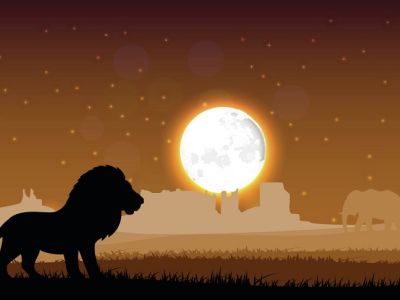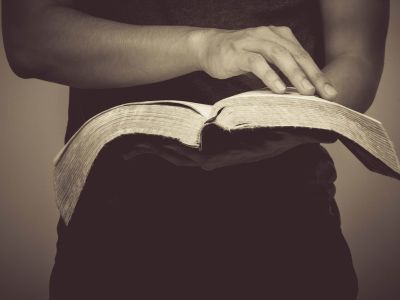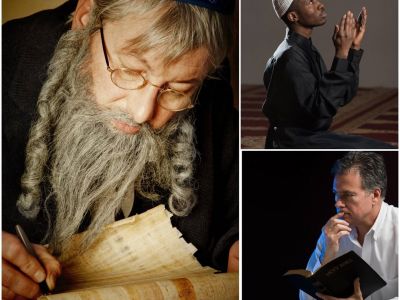The History, Power, and Connections to our Messiah. Should we celebrate Yom Kippur, the Day of Atonement, as believers in Christ? Isn’t this a Jewish holiday? Why is this day considered the holiest day of the year in the Bible? This article will discuss the powerful connections and the significant reasons why every believer in Yeshua should not only understand this holiday but should esteem it with the greatest reverence.
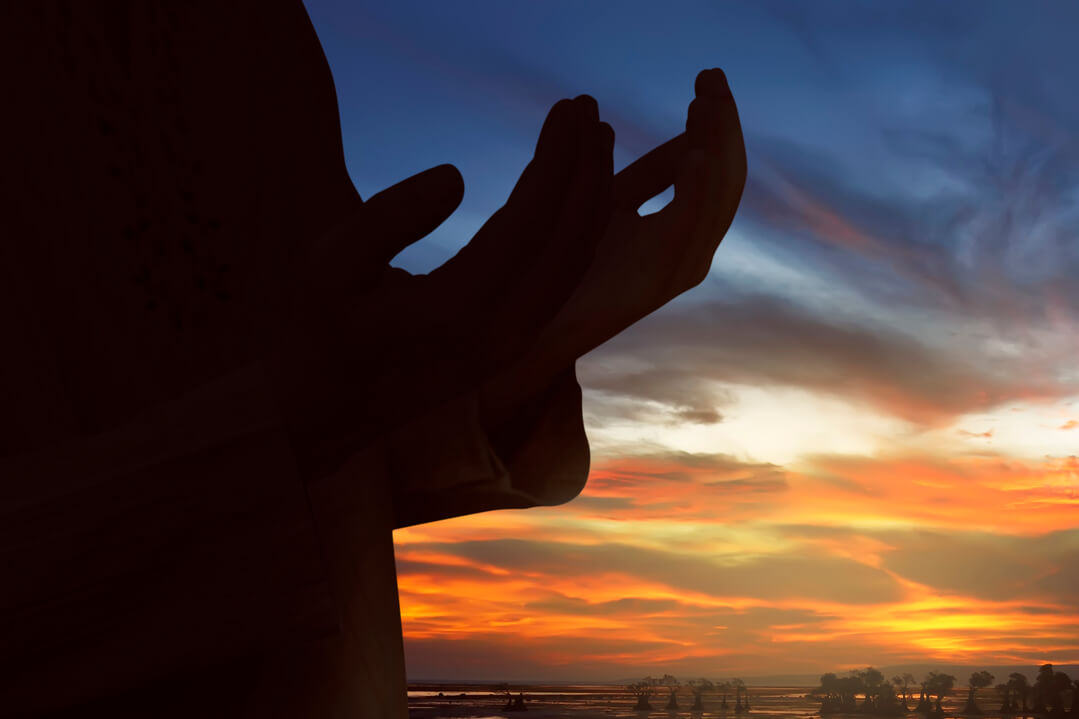
From the very beginning of time, it has always been God’s intention to have a deep, intimate connection and relationship with His people. But ever since the dawn of sin, a wall of separation was built between man and his Creator, a separation that deeply grieved the heart of God. It would be 4000 years until His Son could permanently remove that wall, but something had to be done in the meantime to re-establish a communal relationship. That “something” was the sacrificial feast day system that allowed an innocent animal to take the place of guilty man, paying the price that man should have paid so that he could be right before his Maker.
The most significant of those sacrificial feast days was Yom Kippur–the Day of Atonement. It was the most solemn and most holy day on God’s prophetic calendar. It was the day that Israel would discover whether she would be forgiven of all her sins or not. This was the day that the entire nation would depend on the actions of one single man, the Kohen Hagadol, the High Priest of Israel.
In the days of the Temple, the Kohen Hagadol would begin the preparations for this holy day right after Rosh Hashanah that happened on Tishrei 1, nine days prior. Tishrei 1 is the day of the blowing of the trumpets and the day that the kings of Israel were coronated. It was the beginning of the civil new year and because the Messiah would be the future new King crowned on this day, it also symbolically became the beginning of the Judgment of God. A new King meant a new establishment of a new order. Anyone that would not submit to His new order of law would be destroyed and the last day to pay loyal homage to this King was none other than Yom Kippur. This was the final day of judgment: “Judgment Day.”
The Kohen Hagadol
Seven days before this day the Kohen Hagadol would consecrate himself, read aloud the Scriptures and spend his time repenting of his sins and recognizing his need for forgiveness and repentance. He dare not focus at all on the greater sins of Israel or even a single man; for he was commanded to become right before God first before he could represent the people to their Maker.
The evening before Yom Kippur, the High Priest would read the instructions and procedures that would follow the next day. The gravity of this day would no doubt be forced upon him as he was reminded that the entire future of Israel for the coming year was dependent on him doing everything exactly according to command. At dawn, he would bathe himself and with the help of his Levitical assistants, he would begin the process of putting on the golden vestments that were the hallmark symbol of his office. The High Priest in all his glory even looked like a royal king. The Levites sang songs of praise as the morning sacrifices were offered in the background. The day had begun.
Soon after the sacrifices were offered in the courtyard, the High Priest would disrobe from his royal attire and clothe himself in the simple white linen robe. This simple adornment would symbolize that no royal attire, no jewels or gold of any beauty could compare or stand before the living God. The simplicity of the moment would be a profound and prophetic foreshadow of the coming High Priest, Jesus/Yeshua our Messiah, who was clothed in humility and hung arms open wide in humble nakedness before Yahweh, the God of Israel.
As the High Priest prayed and asked for forgiveness for him and his household, he pronounced the ineffable name of God, Yahweh, for the first time since last Yom Kippur. When the people heard the name being pronounced, they fell on their faces and declared, “Blessed be His glorious Name, whose kingdom is forever!” The reconnection to their Elohim had begun.
When the traditional sacrificial goats were ready and the Kohen Hagadol had fully prepared himself to be a mediator between the people and Yahweh, he went out the eastern gate of the Temple where the two goats stood and drew lots for which one would be the goat for God and which would be the goat for Azazel, the scapegoat. Once the scapegoat was chosen, a scarlet cloth, representing the stains of our sins, was tied to its head and the High Priest would place his hands on the head of the animal to confess all the sins of Israel. He was transferring the sins of the people onto the goat for Azazel. Azazel was a symbol of the serpent in the Garden, that Fallen Angel that deceived mankind and caused God’s prized creation to sin. Due to his deception, the Creator ultimately blamed him for the sins of mankind. So when the Priest was transferring the sins to the Azazel goat, in a real sense he was transferring the sins of Israel to Satan himself. Once the transfer was complete, they would lead the goat out into the wilderness and push it off a cliff, scattering its bones among the rocks. Someday, the adversary of Yahweh will be vanquished, once and for all, never to deceive the nations again!
The High Priest would first enter behind the veil and into the presence of the Almighty Holy One of Israel with an offering of incense and with the blood of the bull, a sin offering for himself. He would sprinkle the blood on the Mercy Seat seven times and then exit the Temple. After he had finished making restitution for his own sins, he was then qualified to administer the offering for all of Israel. Once the sins of Israel were transferred to the unlucky representative of Satan himself, the ones who were the recipient of that deception–Israel–had to make restitution for their part in the fall. This payment was the laAdonai goat for God. The Priest took the blood of the laAdonai goat, which was the offering to Yahweh for the sins of Israel, and entered back into the Holy of Holies to sprinkle the blood just had he did before.
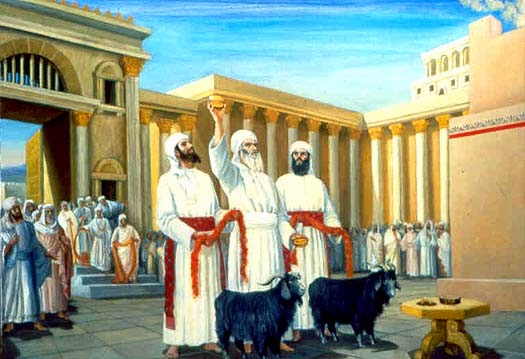
All of this sprinkling would not only cover the Mercy Seat in blood, but would also cover his brand new, white, linen robes in blood as well, turning much of his garment pink. Pink is the combination of pure white and blood red. It represented new birth, a new creation, and the beginning of new authority. (As a side note, in antiquity, the color for boys was pink and the color for girls was blue.)
While the Kohen Hagadol was in the Most Holy Place, he prayed a prayer for the people of Israel, asking the Holy One to forgive and cover the transgressions of His people. And once again, when the priests heard the glorious name of their Creator, they responded by prostrating themselves on the ground and crying out, “Blessed be His glorious Name, whose kingdom is forever!”
At that moment, the High Priest would stand in the gap between the sinful people and the Lord Himself. There was a silence as the decision was made. If the High Priest’s repentance was not adequate or his sacrifice incomplete, the Spirit of God would strike down their representative dead and there would be no atonement for the children of Israel. If their mediator survived and completed his task, he would freely walk out from the meeting place with the Almighty, his face shining like the face of Moses when he was in the presence of the King of Israel. It would be at this point that one of the priests that attended the Azazel goat would report that the crimson cloth tied to the animal’s neck had turned white, a symbol that their sins had been made white as snow. The people would cheer in praise and thanksgiving to their King for once again covering over their sins and bringing them close for another year. They were forgiven.
NOTE: It is important to point out that the blood of bulls and goats, or any other animal for that matter, never brought forgiveness. Animals cannot forgive, nor do they bring forgiveness. It was YHWH that forgave and it wasn’t because of the blood of the animals but because of the obedience that was mixed with faith. It has always been by grace through faith and not of works that any man should boast, as the apostle Paul says. But it is through our obedience that we demonstrate our faith because faith without our works to back it up is dead, as James says.
Bottom line? Forgiveness is a matter of the heart that is proven by true and real-life repentance, and then backed up with the works that He told us to do. The killing of an innocent animal was His way of making them see the gravity of their sin. If you had to kill one of your animals because of your sin, that moment is supposed to impact you greatly. Something would have to die because of your sinful choice. The entire system was to emphasize the gravity of our sin and underscore the grave consequences thereafter.
THE CONNECTION
In the same way that the crimson cloth turned white, for all those that have allowed the blood of the Son of God to cover their robes, so our sins have become white as snow as well. We have passed from death unto life. Yeshua not only became the High Priest in the order of Melchizedek, He also became the Azazel goat that took on all the sins of Israel; and He also became the restitution offering, the laAdonai goat, to Yahweh. Yeshua took every symbolic part of this most solemn holy day and fulfilled them to the tee. He was worthy to be the Mediator because He had no sin; He gave His life as the laAdonai goat did to pay for the sins of Israel, and He accepted all the sins of Israel upon Himself. It would not be time to transfer the sins of mankind to the evil one just yet. That day would come soon enough on the final Yom Kippur at the end of time.
Kippur is spelled kaph, pey, resh. The ancient Paleo, pictograph Hebrew meaning of this word is striking. Kaph was a picture of a cupped hand that would be placed upon the head of someone that was being endowed with new authority. It was the letter of anointing as all the kings and priests were anointed by the laying on of hands. Pey was a picture of a mouth and meant just that, and Resh was a picture of a head and still means that today. This one simple word, one of the holiest words in the Hebrew language, teaches us that our hands, our mouth and our head are to be highlighted this day. When the angel of the Lord took the coal from the altar and touched it to Isaiah’s lips, he became ready for service. When the anointed hand of Yahweh touches your mouth, He is cleansing the main instrument that makes the entire head holy. “For by your words you shall be justified, and by your words you shall be condemned.”(Matthew 12:37) And in a similar application, when the cupped hand (Kaph) is placed over the mouth (Pey), it prevents one from saying something in the heat of a moment that he might regret. This allows his head (resh) to remain holy.
In modern Hebrew, the word Kippur comes from the root word kaphar, which is spelled with the exact same letters. It means to “cancel, purge, reconcile, cover or ransom.” In the secular sense, it mostly means to purchase something or someone with money out of slavery or a similar condition; and this is what Yahweh did for us. He purchased us, redeemed us from slavery, and covered our sins by the blood-price of His Son. This ransom canceled our sins, purged our temples and made us legitimate heirs in His house.
THE PASSOVER CONNECTION
While all the feast days are independently named, they are all intimately connected. From Passover to Sukkot, they each share that same scarlet thread. The three feasts in the Spring (Passover, Unleavened Bread and First Fruits) are all grouped tightly together because they are all really one single feast but with three clearly identifiable components. The same goes for the fall feasts of Trumpets, Atonement and Tabernacles. Shavuot is by itself because it is the center part of the symbolic menorah, with its own unique meanings, holding the two sets of feasts on each side and connecting them both together in itself; but Passover and Yom Kippur are intimately connected, as they both stand as representative feasts of each group.
Passover is the pinnacle of the remembrance of the Israelites leaving Egypt. It culminates with the blood of the Passover Lamb redeeming the firstborn and thus ensuring another generation of family priests in each home. It was a memorial offering and a fellowship–offering that was eaten with God, if you will–in the form of the Seder–in remembrance of that first Exodus. It set the stage that something had to die in order to have a relationship with the King. Today, that “something” is to be us. We are to die to ourselves so that we can live unto Him.
In ancient Israel, Passover and Yom Kippur were disconnected, symbolizing two different actions that accomplished two different things; one that was a memorial celebration of leaving Egypt and one that was the forgiveness of their sins each year. It was only the blood of Yeshua, the Passover Lamb of God, that connected all of them together; for it was that first Passover that was really like Yom Kippur. It was not a memorial offering but a sure judgment for all the sins of Egypt. It was “Judgment Day” for everyone that chose not to–by faith through works–take the blood of the innocent animal as a substitution of his own; thus submitting and recognizing that Yahweh was the one true God and to Him all allegiance was owed.
Their demonstrable faith covered (kippur) them and protected them from the judgment of God. That is exactly what Yom Kippur is all about. The difference being that instead of the head of the house placing the blood of the lamb on the doorpost of his house to protect his firstborn, the true Head of the House (Yahweh) put the blood of His only Son on the doorposts of our hearts, connecting both Passover and Yom Kippur together as one. Incredibly, the Passover lamb and the Yom Kippur goats were both raised in the same Bethlehem, in the same Levitical barn, and eating out of the same feeding trough where Yeshua was born.
So should we as believers in Messiah celebrate this most holy day? Out of all the days of the year, this day commemorates more of what Jesus/Yeshua did for us than any other. If He took the time to take on the role of the High Priest and place His own blood on the altar in heaven on this special day, then the very least that we can do is to honor that act by remembering and observing this day as well. When we fast and afflict ourselves from our normal activities, as the Scriptures say (Leviticus 23), we are becoming like the angels who need not the food of this world, but only to praise and honor the King as they receive the bread from heaven. Out of every other day of the year, it is this day that we bow before our King in humble adoration and thank Him for covering, purging, canceling and reconciling our sin. It is on this day that it is most appropriate to pray:
Our Father, who art in heaven, hallowed be Your name. Your kingdom come, Your will be done, on earth as it is in heaven. Give us this day our daily bread and forgive us our trespasses as we forgive those who trespass against us; and lead us not into temptation, but deliver us from evil. For Yours is the kingdom, the power and the glory, forever and ever. Amen.
Shalom,
Jim Staley







